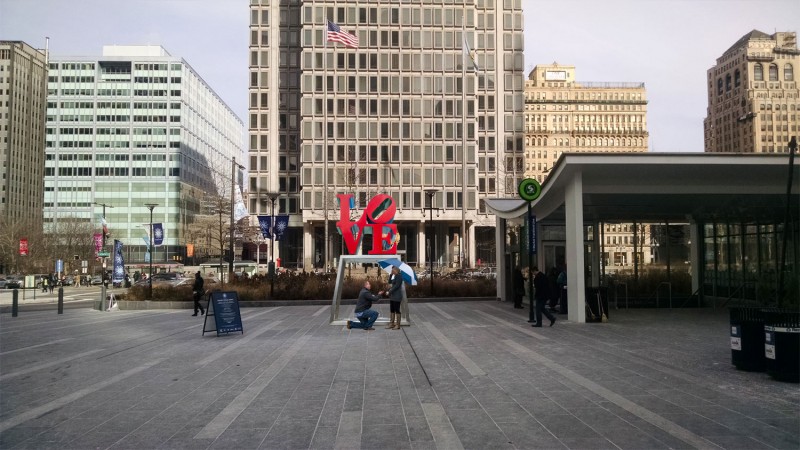It’s official—on Wednesday, Feb. 3, the Art Commission approved relocating Robert Indiana’s iconic LOVE sculpture.
LOVE Park, officially known as John F. Kennedy Plaza (see footnote), will be undergoing its major renovation this year. The Art Commission has already approved this design, with the caveat that they include two water fountains. If you’ll miss the current Edmund Bacon design, be sure to visit LOVE Park before the end of February 2016 to get one last look, as it then transitions to another construction site of downtown Philadelphia for the rest of 2016.

Since it’s the property of our fair city, the Public Art office is responsible for LOVE during the construction phase. Director Margot Berg stated these criteria for the new site: LOVE would need to remain in Center City, so that tourists could still easily visit the sculpture, and the site would need to allow for room around the base of the sculpture, so visitors could gather and congregate, and still take a great photo. Of all the sites considered, the northwest corner of Dilworth Plaza emerged as the best candidate, with the Municipal Services Building (and old Frank Rizzo at the steps) towering behind it. The move is expected to occur on Feb. 23—after Valentine’s Day. An art handling crew will place the sculpture onto dollies and roll it over to the southeast corner of LOVE Park, where a forklift will drive the work to a new temporary location on a new temporary base at Dilworth Park.
The Art Commission readily approved this proposal, but if you consider the LOVE sculpture’s history, the result is not as automatic as it may seem. That LOVE avoided storage during the park’s construction is the first minor blessing. A warehouse in Swedesboro, N.J. has stored decommissioned works of public art for upwards of 20, even 40 years. Even worse, works in storage can often go missing, as the school district discovered during the audit of their collection in 2004, finding that up to 24 artworks, just from the Wilson Middle School, were unaccounted for.
The other consideration is the history of Philadelphia’s LOVE sculpture itself. LOVE was not the artwork commissioned for the park: that honor belongs to the “large fountain with a single burst of water, mirroring the fountains halfway down the Parkway in Logan Square and at the other end on Eakins Oval”. The work stems from a design by Robert Indiana for a MoMA Christmas card in 1964. This sculptural LOVE came to Philadelphia as a loan to the city for a bicentennial celebration in 1976. It remained at JFK Plaza for another two years, at which point, Indiana’s gallery attempted to sell the sculpture to Philadelphia. When the sale stalled, the gallery in 1978 took it to New York for viewing by a potential buyer. A public uproar ensued, and eventually, F. Eugene Dixon, local businessman and then chairman of the Philadelphia Art Commission, purchased the work and donated it to the city.
Almost 50 years after the first Percent for Art ordinance (in Philadelphia!), modern cities are keenly aware of the burden of maintaining large public art collections. This colors any decision to accept new donations of work, and even if successful, donated artworks maintain a different value. These are works that have circumvented the legal commissioning processes, and can have complex legacies, i.e. the “Rocky” statue.
Although LOVE is beloved, it wasn’t automatic to see LOVE remain in the public sphere. It’s a hugely positive sign that our civic leaders recognize the importance of the LOVE sculpture as a civic icon of the City of Philadelphia. So, this Valentine’s Day, let’s recognize this action, and those behind it, and spread the love!
(1) Your dear writer would like to point out that through the sheer success of this public sculpture, the official name of the park—and one of the most famous presidents of all time—has become the secondary and less recognizable moniker of this public space.









